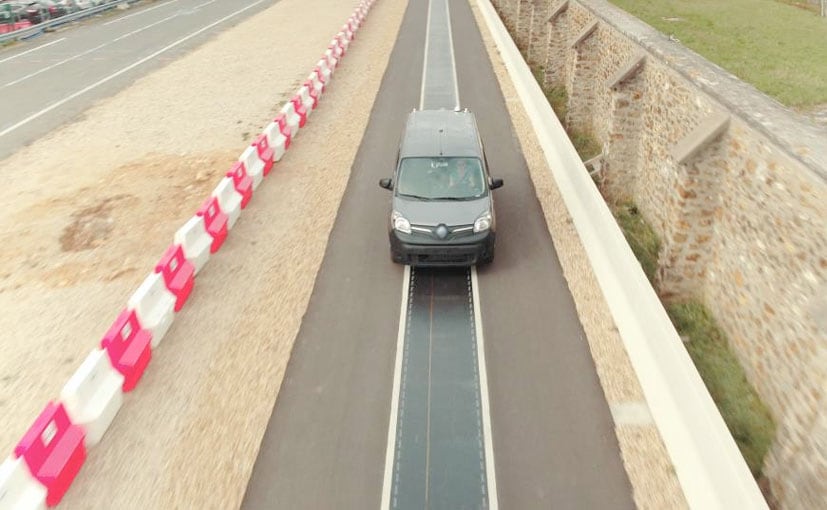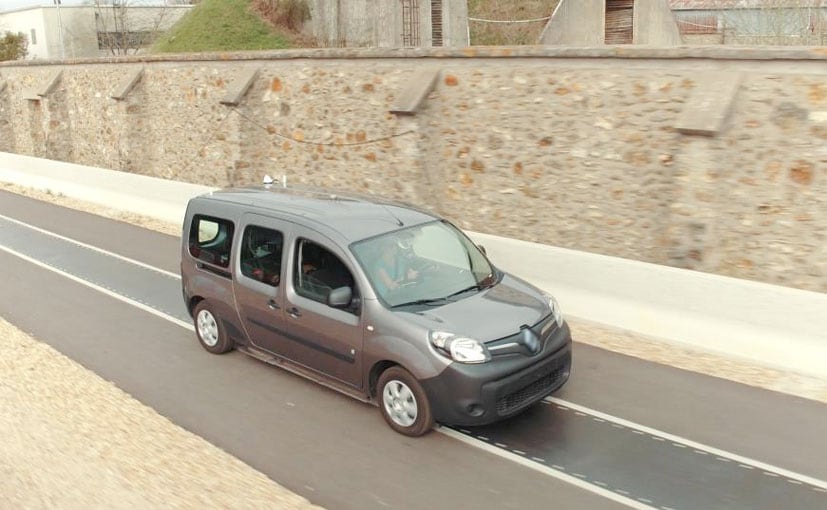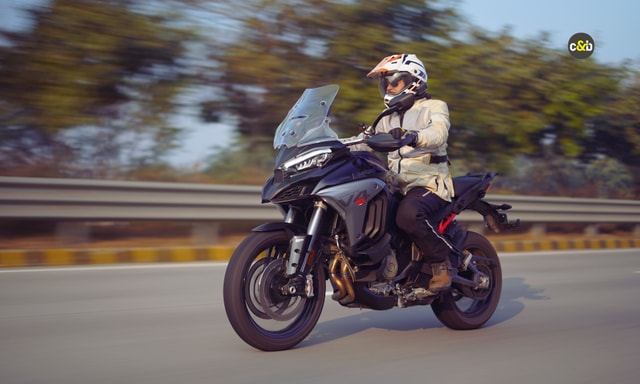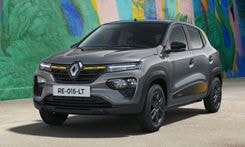Renault Showcases New System That Can Charge Vehicles While Driving

- Renault used two Kangoo Z.E. vehicles for the demonstration
- The demonstration was organised at the test track built by Vedecom
- It can dynamically charge EVs at speeds up to, and in excess of, 100 kmph
Partly funded by the European Union, FABRIC is a €9 million project that started in January 2014 and will continue through December 2017. Undertaken by a consortium of 25 partners from nine European countries, it concentrates on the technological, economic, and socio-environmental viability of wireless DEVC. The primary goal, however, is to organize feasibility analysis of wireless DEVC as a means of EV range extension.
Eric Feunteun, Electric Vehicle Program Director, Groupe Renault, said, "Contributing to this exciting project has enabled us to test and further research dynamic charging on our Kangoo Z.E. vehicles. Our research engineers have worked very closely with the Qualcomm Technologies and Vedecom teams to complete the DEVC system integration demonstration as part of FABRIC. We see dynamic charging as a great vision to further enhance the ease of use of EVs, and the accessibility of EVs for all."

Renault developed the DEVC System with Qualcomm Technologies and Vedecom
Qualcomm Technologies and Vedecom installed the primary component of the DEVC system in the test track, whilst Vedecom and Renault installed the secondary part onto two Renault Kangoos Z.E.. The system will soon be handed over to Vedecom to perform tests for FABRIC where it will evaluate the operation and efficiency of energy transfer to the vehicles for a wide range of practical scenarios including vehicle identification and authorization on entering track, power level agreement between track and vehicle, speed, and alignment of vehicle along track.
Steve Pazol, vice president and general manager, Wireless Charging, Qualcomm Incorporated, said, "We are inventors. We are wireless electric vehicle charging. This dynamic charging demonstration is the embodiment of this. I am immensely proud of what we have achieved. The combination of a global team of expert engineers and Qualcomm Halo technology, which covers all aspects of WEVC systems, irrespective of the magnetics used, has enabled us to really push the boundaries of the possible and outline our vision for future urban mobility."
Trending News
 1 min readYamaha YZF-R2 Name Trademarked In India
1 min readYamaha YZF-R2 Name Trademarked In India
Latest News
 car&bike Team | Dec 21, 2025KTM To Host First Adventure Rally In India In Feb 2026KTM also announced a third season of its KTM Cup for India, which commences in January 2026.1 min read
car&bike Team | Dec 21, 2025KTM To Host First Adventure Rally In India In Feb 2026KTM also announced a third season of its KTM Cup for India, which commences in January 2026.1 min read car&bike Team | Dec 20, 2025KTM 390 Adventure R To Be Launched In January 2026Bookings for the KTM 390 Adventure R are expected to open very soon, wit deliveries beginning in January 2026.2 mins read
car&bike Team | Dec 20, 2025KTM 390 Adventure R To Be Launched In January 2026Bookings for the KTM 390 Adventure R are expected to open very soon, wit deliveries beginning in January 2026.2 mins read car&bike Team | Dec 20, 2025BMW Motorrad India To Hike Prices By Up To 6 Per Cent From 2026The price hike will come into effect from January 1, 2026, and will be across the range of BMW two-wheelers and is due to the rupee’s sharp depreciation.1 min read
car&bike Team | Dec 20, 2025BMW Motorrad India To Hike Prices By Up To 6 Per Cent From 2026The price hike will come into effect from January 1, 2026, and will be across the range of BMW two-wheelers and is due to the rupee’s sharp depreciation.1 min read car&bike Team | Dec 19, 2025Next-gen Audi Q3 Spied In India Ahead Of Launch In 2026Third-gen Q3 made its global debut in mid-2025, getting notable tech upgrades and electrified powertrain options.2 mins read
car&bike Team | Dec 19, 2025Next-gen Audi Q3 Spied In India Ahead Of Launch In 2026Third-gen Q3 made its global debut in mid-2025, getting notable tech upgrades and electrified powertrain options.2 mins read car&bike Team | Dec 19, 2025Yamaha YZF-R2 Name Trademarked In IndiaThe Yamaha R15, one of Yamaha India’s most popular motorcycle models, is likely to continue, even when the R2 finally makes it debut.1 min read
car&bike Team | Dec 19, 2025Yamaha YZF-R2 Name Trademarked In IndiaThe Yamaha R15, one of Yamaha India’s most popular motorcycle models, is likely to continue, even when the R2 finally makes it debut.1 min read car&bike Team | Dec 18, 2025KTM 160 Duke With TFT Dash launched At Rs 1.79 LakhThe 5-inch colour TFT dash is borrowed from the 390 Duke and is shared across the brand’s sub-400cc lineup.2 mins read
car&bike Team | Dec 18, 2025KTM 160 Duke With TFT Dash launched At Rs 1.79 LakhThe 5-inch colour TFT dash is borrowed from the 390 Duke and is shared across the brand’s sub-400cc lineup.2 mins read
 Bilal Firfiray | Dec 19, 2025Maruti Suzuki e-Vitara Review: Worth The Wait?After a long wait, the first-ever electric Maruti Suzuki is here. It’s the e-Vitara, and it comes with a few promises. But arriving this late, is it worth the wait? Or is it a case of too little, too late?9 mins read
Bilal Firfiray | Dec 19, 2025Maruti Suzuki e-Vitara Review: Worth The Wait?After a long wait, the first-ever electric Maruti Suzuki is here. It’s the e-Vitara, and it comes with a few promises. But arriving this late, is it worth the wait? Or is it a case of too little, too late?9 mins read Bilal Firfiray | Dec 18, 2025Mercedes-Benz G450d: The Subtle Power of EvolutionThe Mercedes-Benz G 450d evolves subtly with more power, improved efficiency, and modern tech, while staying true to the timeless G-Class design. And character.4 mins read
Bilal Firfiray | Dec 18, 2025Mercedes-Benz G450d: The Subtle Power of EvolutionThe Mercedes-Benz G 450d evolves subtly with more power, improved efficiency, and modern tech, while staying true to the timeless G-Class design. And character.4 mins read Janak Sorap | Dec 11, 2025Harley-Davidson X440 T First Ride Review: Smarter and SharperHarley-Davidson has taken the X440 and given it a more focused and engaging twist. The result is the X440 T—essentially the same platform but updated in areas that give the motorcycle more appeal and riders more thrill.5 mins read
Janak Sorap | Dec 11, 2025Harley-Davidson X440 T First Ride Review: Smarter and SharperHarley-Davidson has taken the X440 and given it a more focused and engaging twist. The result is the X440 T—essentially the same platform but updated in areas that give the motorcycle more appeal and riders more thrill.5 mins read Shams Raza Naqvi | Dec 10, 20252025 Mini Cooper Convertible Review: More Colour On Indian RoadsThe updated Mini Cooper Convertible is set to be launched in the Indian market in the next few days. We drive it around Jaisalmer for a quick review.5 mins read
Shams Raza Naqvi | Dec 10, 20252025 Mini Cooper Convertible Review: More Colour On Indian RoadsThe updated Mini Cooper Convertible is set to be launched in the Indian market in the next few days. We drive it around Jaisalmer for a quick review.5 mins read Preetam Bora | Dec 21, 20252025 Ducati Multistrada V4 S Review: Seriously Addictive!For 2025, the Ducati Multistrada V4 gets sharper, smarter and more sophisticated. We spent several days with the updated Multistrada V4 S to answer the big question – with a price tag north of Rs. 30 lakh, is it worth splurging?8 mins read
Preetam Bora | Dec 21, 20252025 Ducati Multistrada V4 S Review: Seriously Addictive!For 2025, the Ducati Multistrada V4 gets sharper, smarter and more sophisticated. We spent several days with the updated Multistrada V4 S to answer the big question – with a price tag north of Rs. 30 lakh, is it worth splurging?8 mins read


































































































































